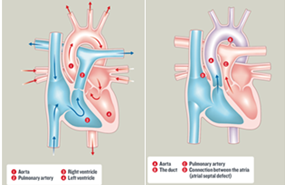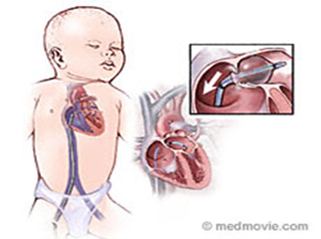Department of Cardiology and Cardiac Surgery
On this page
Download leaflet
Balloon Atrial Septostomy for Transposition of Great Arteries TGA PIAG 275 (253kB pdf)
Introduction
In Transposition of the Great Arteries (TGA), the aorta and pulmonary arteries are swapped, causing two disconnected blood circulation-oxygen-rich (“red”) blood flows only to the lungs, while the oxygen-poor (“blue”) blood circulates only through the heart and the body. The immediate concern after birth is how low are the oxygen levels. About half of babies with TGA, without a Ventricular Septal Defect (VSD), require a septostomy.

Delivery at Liverpool Women’s Hospital (via vaginal delivery or caesarean section)
The neo-natal team will be present for the delivery, and afterwards they will monitor baby’s condition, including oxygen levels, heart rate, breathing rate, blood pressure and blood levels.
They will insert some lines (these may be in veins in the hands or feet or the belly button) so they can start baby on IV Prostin (this is the medicine that keeps the duct open to allow some mixing of red and blue blood). They may need to do a chest x-ray and then arrange urgent transfer over to Alder Hey – usually within 1-2 hours.
What is a balloon atrial septostomy (BAS)?

This is a keyhole (cardiac catheter) procedure that enlarges a naturally occurring hole (called the foramen ovale) between the left and right atria (the two collecting chambers of the heart).
The BAS is performed by a paediatric cardiologist in Alder Hey Children’s NHS Foundation Trust, under general anaesthesia in the cardiac catheter laboratory. Ultrasound and/or X-ray guidance may be used for the procedure.
A long tube called a ‘catheter’, with a deflated balloon at the tip, is introduced into the body through a blood vessel in the groin or belly button. The catheter is passed into the heart where it crosses a hole (foramen ovale) into the left collecting chamber (left atria). The balloon is inflated and then pulled across the hole into the right collecting chamber (right atria) tearing the wall between the chambers to allow the blood to mix and flow around the body to increase oxygen levels. The BAS is a temporary measure until your baby has a surgical repair – usually the switch operation.
What are the risks?
A balloon atrial septostomy is considered a low-risk procedure. The risks will depend on your baby’s overall health. The cardiologist will obtain your consent for the procedure – this can be done over the phone or in person. We are not able to take consent for the procedure before babies are born.
These risks include:
Bruising at the groin, blood clot, infection, bleeding, arrhythmia (refers to a fast, slow, or irregular heartbeat), stroke or death (very small risk).
What will happen after the procedure?
Your baby will be transferred to the Paediatric Intensive Care Unit (PICU) until they are well enough to go to the cardiology ward (Ward 1C).
After the procedure, the PICU team will aim to reduce ventilation and remove the breathing tube and other medical support, depending on how stable they are. Most babies need about 24-48 hours on PICU after the septostomy. A small number of babies may need longer.
Fetal Cardiac Nurse Specialists
- If you have further questions, please contact the Fetal Cardiac Nurse Specialists on 0151-252-5642 Monday-Friday (excluding bank holidays & weekends). The line will be checked daily at midday and we will respond to your query as soon as we can; if a more urgent response is needed please call the main helpline number on 0151-252-5291.
This leaflet only gives general information. You must always discuss the individual treatment of your child with the appropriate member of staff. Do not rely on this leaflet alone for information about your child’s treatment.
This information can be made available in other languages and formats if requested.
PIAG: 275